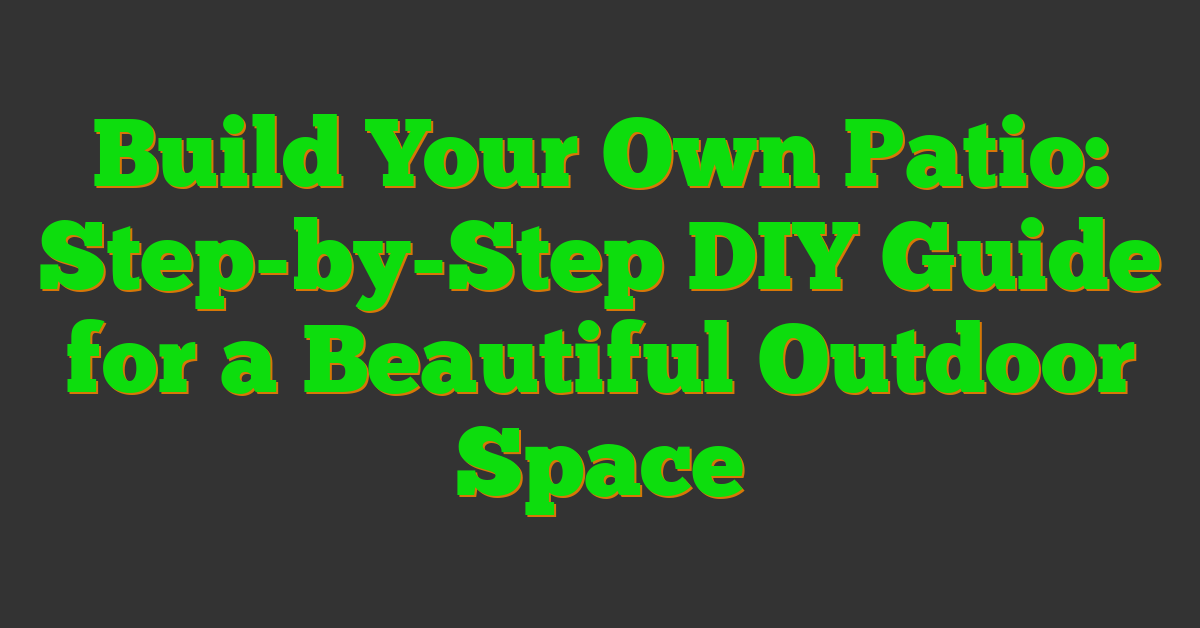Imagine sipping your morning coffee or enjoying evening barbecues in your very own patio. Building a patio might sound daunting, but with the right guidance, it’s a project you can tackle yourself.

I’ve walked through the steps, picked up useful tips, and avoided common pitfalls so you can create a space that’s perfect for relaxing and entertaining. Whether you’re a seasoned DIYer or just starting out, this guide will help you build a patio that adds both beauty and value to your home.
Overview of Build Your Own Patio: DIY Guide
Building a patio involves several key steps that ensure a sturdy and attractive outdoor space. I start by selecting the right location, considering sunlight exposure and drainage. Next, I gather essential materials like concrete, pavers, gravel, and landscaping fabric.
Planning plays a crucial role in a successful DIY patio project. I create a detailed layout, measuring the area accurately to determine the materials needed. The preparation phase includes marking the patio boundaries and excavating the site to the required depth, which prevents future settling issues.
To streamline the process, here’s a table outlining common patio materials and their uses:
| Material | Purpose |
|---|---|
| Concrete | Foundation and surface |
| Pavers | Decorative and functional |
| Gravel | Base layer for drainage |
| Landscaping Fabric | Weed prevention underneath |
Following these steps and using quality materials helps me build a durable and appealing patio that enhances my outdoor living space.
Tools and Materials Needed
Here’s what I use when building my patio, including essential tools and recommended materials.
Essential Tools
- Measuring Tape: Ensures accurate measurements and layout.
- Level: Helps maintain a flat, even surface.
- Shovel: Perfect for digging and excavation.
- Pickaxe: Breaks up hard ground effectively.
- Wheelbarrow: Makes transporting materials easier.
- Rubber Mallet: Sets pavers without causing damage.
- Spirit Level: Provides precision during installation.
- String and Stakes: Marks boundaries and layout lines.
Recommended Materials
| Material | Purpose |
|---|---|
| Concrete | Forms a stable foundation |
| Pavers | Adds a decorative surface to the patio |
| Gravel | Enhances drainage beneath the patio |
| Landscaping Fabric | Prevents weed growth under the patio |
| Sand | Acts as a bedding layer for pavers |
| Edging Material | Keeps pavers in place and defines edges |
Step-by-Step Instructions
Follow these detailed steps to build your patio efficiently.
Preparing the Site
I start by clearing the area where the patio will be built. Removing grass, weeds, and debris ensures a stable base. Next, I level the ground using a shovel and a tamper to prevent future settling. If the site has poor drainage, I add a gravel layer to improve water flow. Finally, I mark the patio boundaries with string and stakes to outline the exact shape.
Laying the Foundations
I choose the foundation type based on the patio design. For concrete foundations, I mix and pour the concrete evenly, ensuring it spreads uniformly. Using a spirit level, I check for a flat surface to maintain stability. If opting for pavers, I lay down a layer of sand as a bedding and compact it with a plate compactor. I arrange the pavers carefully, leaving space for expansion, and secure them with edging material to keep the layout intact.
Design Options
Choosing the right design for your patio ensures it complements your outdoor space and meets your needs. Here are some popular design options to consider:
1. Traditional Patio
A traditional patio features classic materials like brick or natural stone. It offers a timeless look suitable for various home styles.
- Brick: Durable and versatile, bricks come in multiple colors and patterns.
- Natural Stone: Options like slate, flagstone, or granite provide unique textures and appearances.
2. Modern Patio
Modern patios emphasize clean lines and minimalism. They often incorporate contemporary materials and sleek designs.
- Concrete: Smooth finishes and geometric shapes define a modern patio.
- Pavers: Large-format pavers in neutral tones enhance the minimalist aesthetic.
3. Outdoor Living Room
Transform your patio into an outdoor living area with comfortable seating and functional elements.
- Furniture: Include sofas, chairs, and coffee tables for relaxation.
- Lighting: Use string lights or lanterns to create a cozy atmosphere.
4. Dining Patio
Create a dedicated space for outdoor dining, perfect for entertaining guests.
- Dining Set: Invest in a sturdy table and chairs suitable for outdoor use.
- Covering: Add a pergola or umbrella to provide shade and protection from the elements.
5. Multi-Level Patio
Design a patio with multiple levels to define different areas and add visual interest.
- Terracing: Use steps or varying elevations to separate zones.
- Plants: Incorporate raised beds or planters to enhance each level.
6. Indoor-Outdoor Patio
Blend indoor and outdoor living spaces for seamless transitions.
- Sliding Doors: Install large glass doors to connect the patio with the interior.
- Consistent Flooring: Use similar materials inside and out for a unified look.
7. Water Features
Integrate water elements to add tranquility and enhance the patio’s ambiance.
- Fountains: Install a wall-mounted or standalone fountain as a focal point.
- Ponds: Create a small pond with aquatic plants and fish for a natural feel.
Material Comparison
| Material | Durability | Maintenance | Aesthetic Variety |
|---|---|---|---|
| Brick | High | Moderate | Limited colors |
| Natural Stone | Very High | Low | High variety |
| Concrete | High | Low | Good versatility |
| Pavers | High | Moderate | Extensive styles |
Selecting the right design involves balancing aesthetics, functionality, and maintenance. Assess your lifestyle and preferences to choose a patio design that best fits your outdoor living goals.
« Installing a Pergola: Easy DIY Steps to Transform Your Outdoor Space Fertilizing Your Garden: Best Practices for Healthy, Productive Plants »
Cost and Value
Building a patio involves various costs that depend on size, materials, and labor. I typically budget for materials, tools, and any additional expenses.
Cost Breakdown
| Item | Estimated Cost (USD) |
|---|---|
| Concrete | $75 per cubic yard |
| Pavers | $2 to $10 per sq ft |
| Gravel | $15 per ton |
| Landscaping Fabric | $20 per roll |
| Sand | $40 per bulk load |
| Edging Material | $1 to $5 per linear ft |
| Tools Rental | $50 to $150 |
Costs vary based on quality and quantity. For example, choosing high-end pavers at $10 per square foot increases the budget compared to standard options at $2 per square foot.
Value Added
A well-built patio enhances outdoor living spaces and can boost property value. Studies show a quality patio can increase home value by up to 10%. Additionally, it provides a space for relaxation and entertainment, offering personal enjoyment and long-term investment benefits.
Investing in durable materials reduces future maintenance costs. For instance, natural stone pavers may cost more initially but require less upkeep than concrete alternatives. By carefully selecting materials and planning the project, I ensure the patio delivers both immediate enjoyment and lasting value.
Pros and Cons
Pros:
- Cost Savings: Building my own patio reduces expenses compared to hiring professionals.
- Customization: I can design a patio that perfectly fits my specific needs and preferences.
- Sense of Achievement: Completing the project myself provides a rewarding feeling of accomplishment.
- Increased Property Value: A well-built patio can enhance my home’s market appeal and potentially increase its value.
- Flexibility: I have the freedom to choose materials and design elements that align with my vision.
- Time Investment: DIY patio projects can be time-consuming, requiring careful planning and execution.
- Physical Labor: Constructing a patio involves significant physical work, which can be demanding.
- Skill Requirements: Ensuring a sturdy and safe patio requires a certain level of knowledge and expertise.
- Potential for Mistakes: Errors during the build may lead to additional costs or the need for rework.
- Resource Management: Coordinating materials and tools efficiently can be challenging without prior experience.
Conclusion
Building my own patio has been one of the most fulfilling projects I’ve tackled. Watching the space come together piece by piece was incredibly satisfying. I loved how it turned into a perfect spot for relaxing and entertaining.
The effort paid off with a beautiful outdoor area that I can enjoy every day. If you’re thinking about taking on a DIY patio, I encourage you to go for it. With some planning and dedication you can create a space that truly enhances your home and lifestyle.
Here’s to enjoying many sunny days and cozy evenings in your new patio!
















